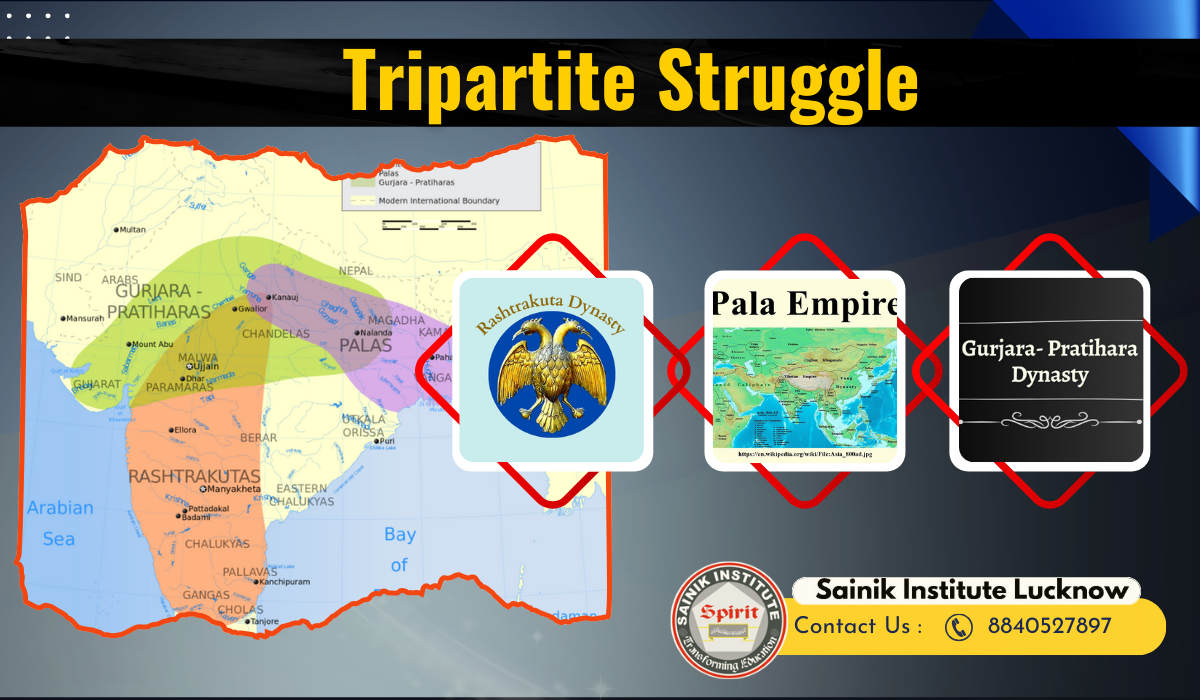Tripartite Struggle By Sainik School Coaching Lucknow Tripartite Struggle also known as The Kannauj Triangle Wars, for control of northern India took place between the Pratihara Empire, the Pala Empire and the Rashtrakuta Empire.
Medival India Medival India Notes  Posted by Priya on 2024-05-15 05:33:59 |
Last Updated by Priya on 2024-11-21 22:49:10
Posted by Priya on 2024-05-15 05:33:59 |
Last Updated by Priya on 2024-11-21 22:49:10
Share:  Facebook |
Facebook |
 Get Inquiry |
Get Inquiry |
 Whatsapp |
Whatsapp |
Share to friend
Views:
2530253
Views: 2530253
The Tripartite Struggle
उत्तरी भारत
पर नियंत्रण के लिए
त्रिपक्षीय संघर्ष, जिसे कन्नौज त्रिभुज युद्ध के रूप
में भी जाना जाता है, नौवीं
शताब्दी में गुर्जर-प्रतिहार साम्राज्य, पाल साम्राज्य और राष्ट्रकूट साम्राज्य के बीच हुआ था। हालाँकि, पुरालेखविद् दिनेशचंद्र सरकार ने इस संघर्ष में एक अलग
परिप्रेक्ष्य जोड़ा।
The Tripartite Struggle, aka The Kannauj Triangle
Wars, was the struggle for the control of northern India that took
place in the 8th and 9th Centuries among the Pratihara, the Pala and
the Rashtrakuta Empire. The struggle centered around the city of
Kannauj, known for its wealth and strategic importance
Dharmpala, the Pala King and Vatsaraja, the Parithara King, struggled for supremacy over Kannauj. Vatsaraja emerged victorious but was later defeated by the Rashtrakuta King Dhurva-I. After the return of Dhruva-I to south, Dharmpala again captured Kannauj, but his occupation was short-lived.
Coaching Centre For Sainik School Entrance Exam Lucknow Best Coaching For Sainik & Military School Preparation For Class VI & IX
Sainik Institute Lucknow Is Result Oriented Institute For Entrance Exam Preparation
For about two centuries, there had been continuous tripartite struggle of kingdoms for the control over Kannauj.
Significance of
Kannauj
Kannauj was located
on the Ganga trade route and was connected to the ‘silk route’. It
made Kannauj strategically and commercially very important. It was also the
erstwhile capital of Harshvardhana’s empire in north India.
Thus, the three Kingdoms fought war against each other to take advantage of the immense economic and strategic potentialities of Kannauj.
Causes for
Tripartite Struggle
To get control over
Gujarat and Malwa, the regions were very important for foreign trade due
to their nearness to the coast.
To acquire
supremacy over Kannauj, a symbol of prestige in Indian politics.
To get control over
the vast resources of the Gangetic valley.
Desire to impress
the pretty kingdoms with the sense of their might.
Lust for war
booty, a prominent source for maintaining huge army.
Tripartite Struggle
– Phase I
A tripartite struggle occurred
between the Pala, Prathihara, and Rashtrakuta dynasties for control of Kanauj.
The first
phase of the tripartite struggle began around 790 AD with a
clash between Dharmapala and Vatsaraja.
The battle between
Dharmapala and the Pratihara king Vatsaraja at Prayag resulted in the
defeat of Dharmapala.
After some time
Vatsaraja was defeated by Rashtrakuta king Dhruva.
Dharmapala
took control of Kannauj after Vatsaraja’s fall, but he was again
defeated by Dhruva.
Dhruva, on the
other hand, was unable to consolidate his victory because he needed to return
to the south to save his own kingdom.
Rashtrakutas were
devastated by a succession struggle after Dhruva’s death in 793 CE.
By quickly
withdrawing from Northern India, the Rashtrakutas not only decimated the Palas’
adversaries, the Pratiharas but also provided the Palas with a good opportunity
to add to their might.
Dharmapala took
advantage of the situation and recovered Kannauj, putting Chakrayudha on
the throne.
Dharmapala, via a
series of successful expeditions, established himself as the lord of virtually
all of Northern India.
Tripartite Struggle
– Phase II
Pratihara
ruler Nagabhatta II, the successor of Vatsaraja, invaded Kanauj and
expelled its ruler Chakrayudha and established control there.
As Chakrayudha was
Dharmapala’s protege, a battle between Nagabhatta II and Dharmapala was
inevitable.
Nagabhatta II
defeated Dharmapala in a battle near Munger.
After Nagabhata II
took possession of Kannauj, the battle for the city intensified.
His victory was
short-lived, as he was soon overthrown by Govinda III (Rashtrakuta king), the
successor of Dhruva.
Govinda III left
for the Deccan soon after this victory.
By the end of the
9th century, the Rastrakutas’ power had begun to wane alongside that of the
Palas.
The Pratiharas
emerged victoriously and established themselves as the rulers of central
India by the end of the tripartite struggle.
Consequence of
Tripartite Struggle
This tripartite
struggle for Kannauj continued for almost two hundred years and its
result finally ended in favour of the Gurjara-Pratihara ruler
Nagabhata II who made Kannauj the capital of the Gurjara-Pratihara
kingdom. This kingdom ruled for nearly three centuries.
It eventually made all three dynasties weak in the long run, which resulted into the political disintegration of the country and benefited the Islamic invaders from Middleeast in setting up empire in India.
Need More Information:
 Call Now
Call Now